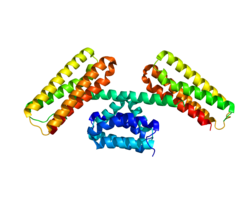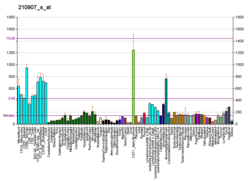Top Qs
Timeline
Chat
Perspective
PDCD10
Protein-coding gene in the species Homo sapiens From Wikipedia, the free encyclopedia
Remove ads
Programmed cell death protein 10 is a protein that in humans is encoded by the PDCD10 gene.[5][6]
Remove ads
Function
This gene encodes a protein, originally identified in a premyeloid cell line, with similarity to proteins that participate in apoptosis. Three alternative transcripts encoding the same protein, differing only in their 5' UTRs, have been identified for this gene.[6]
Gene
Loss of function mutations in PDCD10 result in the onset of Cerebral Cavernous Malformations (CCM) illness.[5] Therefore, this gene is also called CCM3. Cerebral cavernous malformations (CCMs) are vascular malformations in the brain and spinal cord made of dilated capillary vessels.
Interactions
CCM3 encodes a protein called Programmed Cell Death 10 (PDCD10). The function of this protein has only recently begun to be understood. PDCD10 has roles in vascular development and VEGF signaling1,[7] apoptosis[8] and functions as part of a larger signaling complex that includes germinal center kinase III.[9][10] Specifically, PDCD10 has been shown to interact with RP6-213H19.1,[11] STK25,[11][12] STRN,[11] STRN3,[11] MOBKL3,[11] CTTNBP2NL,[11] STK24[11][12][13] and FAM40A.[11]
References
Further reading
External links
Wikiwand - on
Seamless Wikipedia browsing. On steroids.
Remove ads






